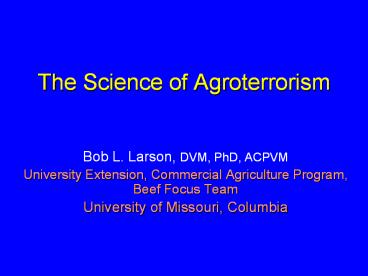The Science of Agroterrorism - PowerPoint PPT Presentation
1 / 16
Title:
The Science of Agroterrorism
Description:
Title: Agricultural Bioterrorism (Agroterrorism) and Biosecurity Author: MO Department of Agriculture Last modified by: Jon Stemmle Created Date – PowerPoint PPT presentation
Number of Views:91
Avg rating:3.0/5.0
Title: The Science of Agroterrorism
1
The Science of Agroterrorism
- Bob L. Larson, DVM, PhD, ACPVM
- University Extension, Commercial Agriculture
Program, Beef Focus Team - University of Missouri, Columbia
2
Ancient Tactic(sieges, battles, wars)
- Burn fields
- Poison wells
- Catapult dead/diseased animals over castle walls
- Etc.
3
(No Transcript)
4
Agricultural Bioterrorism (Agroterrorism)
- Biological Warfare Use of disease to harm or
kill military/civilians, food, or livestock - Agroterrorism Intentional Attack on
Agriculture Infrastructure- Bio Weapons - Assumption - Risks Have Increased for Intentional
Introduction of Diseases (Human Animal)
5
Relevant Terms
- Reservoir the species or location where the
disease organism is typically found, often
asymptomatic - Zoonotic A disease with an animal reservoir
that can be passed to humans - Contagious Disease or agent that can be passed
from one person to another - Levels of contagiousness high, moderate, low,
none - Indirect transmission (insect or animal vector)
- Specific activity (venereal, blood borne)
- FAD Foreign Animal Disease
- Diseases that are not naturally in the U.S. or
were eliminated from the U.S. after an
eradication effort - Trade as well as health issues
- Quarantine - To stop the movement of animals into
or out of an area. To isolate an individual,
herd, area, state, nation, etc.
6
Types of Bioterrorism Agents
- Human disease / reservoir
- Smallpox, Cholera, Shigellosis - contagious
- Zoonotic disease
- Domestic or wildlife animal reservoir
- Anthrax, Brucellosis, Tularemia, Plague,
Encephalitis, Ebola, Q Fever most minimally
contagious - Animal disease
- Foreign Animal Diseases (FAD) ASF, FMD, Avian
Influenza, New Castle, Rinderpest, Hog Cholera - Why Zoonotic?
- Controllable, Many in nature
- Animal Models Politically Legitimate to Research
7
Potential Bioterrorism Agents (CDC categories)
Category A
- Easily transmitted from person-to-person
- High mortality rates
- Potential for major public health impact
- Can cause panic and social disruption
- Requires special action for public health
preparedness - Anthrax, Botulism, Plague, Smallpox , Tularemia,
Viral hemorrhagic fevers (Ebola, Marburg, Lassa,
Machupo)
8
Potential Bioterrorism Agents (CDC categories)
Category B
- Moderately easy to disseminate
- Moderate morbidity and low mortality rates,
- Brucellosis, Glanders, Meliodosis, Psittacosis, Q
Fever, Typhus fever, Viral encephalitis Toxins
(bacterial and plant), Food Safety, Water Safety
9
Potential Bioterrorism Agents (CDC categories)
Category C
- Emerging pathogens
- Could be engineered for mass dissemination
- Available, easy production and dissemination
- Potentially high morbidity and mortality
- Major health impact
- Nipah (Nipah virus), Hantavirus (Hantavirus)
10
Bioterrorism Pathogens For Livestock - Criteria
- Highly Infectious Contagious
- Good Ability to Survive in Environment
- Predictable Morbidity/Mortality
- Pathogenic for Livestock Poultry
- Available Easy to Acquire or Produce
- Attributable to Natural Outbreak Deniable
- Easily Disseminated
11
Awareness of a Bioterrorism Threat
- Producers and Practicing Veterinarians
- 1st Line of Defense
- Sudden, Unexplained Death Loss
- Severe Illness Affecting High of Herd
- Vesicles (Blisters) - Mouth Hooves
- Unusual External Parasites
- CNS signs
12
Bioterrorism Directed Toward U.S.
Livestock/Poultry Industry
- FMD is likely agent of choice of terrorists
- Other possible agents TB, Brucellosis, Avian
Influenza, Hog Cholera, New Castle - Human health impact minimal
- Psychological and economic
- Devastating economic implications to livestock
industry - Possible attacks on processing plants
- (Meat, Milk, Eggs)
13
Biosecurity to Control Disease
- Awareness of Strange Persons/Vehicles
- Restricted Movement Zones - Minimize and Control
Farm Traffic - Management to Prevent Spread of Introduced
Pathogens - Quarantine - Management to Protect Adjacent
Herds From Disease - Disinfection of Personnel and Equipment
14
Economics of Controlling A Foreign Animal Disease
- Stopping Movement Animals Products
- Depopulation of Infected Adjacent Herds
- Disposal of Carcasses
- Disinfection - premises, personnel, vehicles
- Mass vaccination programs (some cases)
15
Keys to Communication
- Reservoir human, domestic animal, wild animal
- Zoonotic terrorism disease without contact
with reservoir species - Contagious Levels of contagiousness
- FAD Foreign Animal Disease
- Trade as well as health issues
- Quarantine Role of local, state, and federal
government (not voluntary)
16
(No Transcript)































